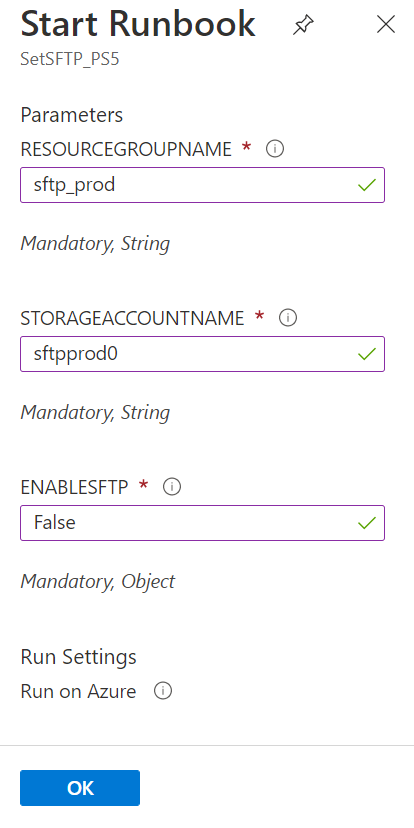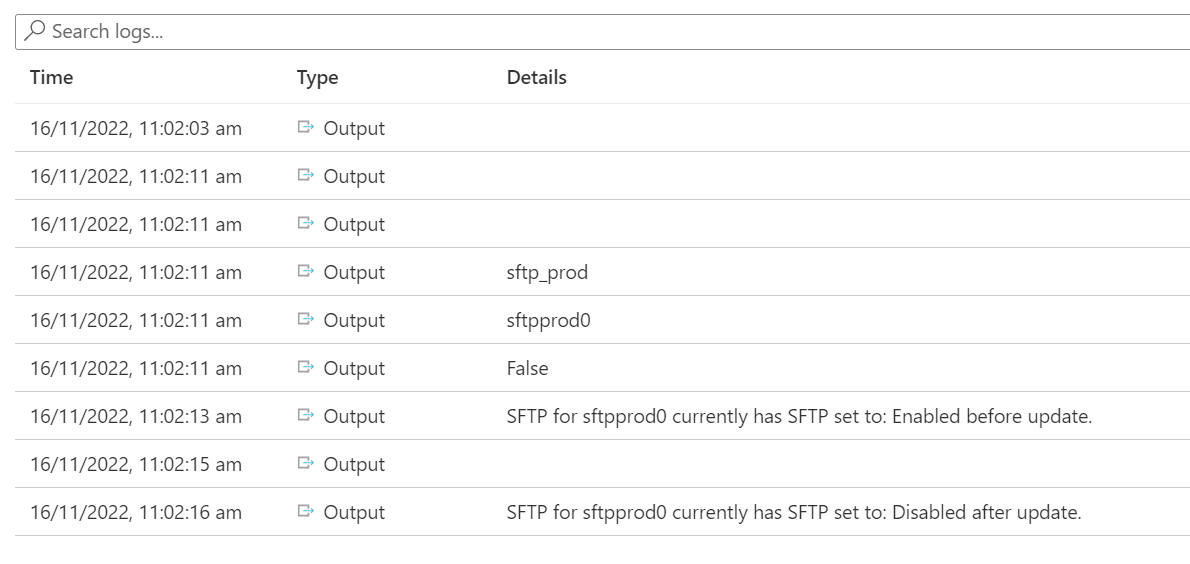Disable SFTP support on an Azure Storage account on a Schedule
Azure Storage account SFTP functionality has now gone GA (Generally Available) across most regions as part of the GA release - SFTP support for Azure Storage accounts was free while it was in preview - but now that the service is GA - there is an additional charge for SFTP (Secure File Transfer) functionality.
Enabling the SFTP endpoint has a cost of $0.30 per hour. We will start applying this hourly cost on or after December 1, 2022.
This service has worked for me without a hitch for months, but as with most resources in Microsoft Azure - you pay for what you use! Therefore, there may be instances where you do not need SFTP support 24 hours a day, seven days a week! This is where the following Azure Automation runbook can help.
Feel free to check out a previous article on setting up SFTP support for an Azure storage account.
Overview
Using an Azure Automation PowerShell runbook and Schedules (as part of the Azure Automation account) - we can turn on the SFTP endpoint - when we need it and disable it - the rest of the time - which is excellent from a security and cost perspective.
Prerequisites
To do this, we will need an:
- Azure Automation Account
- System Managed Identity set with Storage Account Contributor rights
- PowerShell runbook (supplied below)
For this article, I will assume you already have an Azure Automation account - if you do not - then follow the Microsoft documentation: Create a standalone Azure Automation account.
Deploy & Configure
Now that the Azure Automation account has been configured and set up - we need to add the Runbook, but before we can do that - there are some dependencies. For example, SFTP is a new service that the currently installed Az Modules in the Azure Automation don't have visibility on - so to configure the SFTP service - we need to update 2 Modules to the most recent version.
These modules are:
- Az.Accounts (≥ 2.10.3)
- Az.Storage
Az.Accounts are a dependent service of the latest Az.Storage account, so let us import that first.
Update Az.Accounts module
- In the Azure Portal, navigate to Azure Automation accounts.
- Find your Azure Automation account and, click on it, navigate to Modules (under Shared resources).
- Select Browse Gallery
- Search for: Az.Accounts

- Click 'Az.Accounts' and select Select.
- Set the runtime version to: 5.1 & select import
- Wait for 5 minutes while the module imports.
Update Az.Storage module
Note: the Az.The accounts module will need to finish its import before the Az.The storage module is updated.
- In the Azure Portal, navigate to Azure Automation accounts.
- Find your Azure Automation account and, click on it, navigate to Modules (under Shared resources).
- Select Browse Gallery
- Search for: Az.Storage

- Click 'Az.Storage' and select Select.
- Set the runtime version to: 5.1 & select import
- Wait for 5 minutes while the module imports.
Create System Managed Identity
Now that the base Modules have been updated, we need to create a System Managed Identity - this Managed Identity will allow the Azure Automation runbook to authenticate to your Azure resources - and, in our example - make changes, such as Disabling or Enabling the SFTP service. This System Managed Identity will need Storage Account Contributor rights.
- In the Azure Portal, navigate to Azure Automation accounts.
- Find your Azure Automation account and click on it; click on Identity (under Account Settings)
- Select Status to: On and select Save
- Click on: Azure role assignments
- Select your Scope (in our example, we will go with Storage - to limit what changes this Azure Automation account can make)
- Select the Subscription and Storage account Resource on which you want to disable or enable the SFTP service.
- For the role, select Storage Account Contributor.
- Click Save
You should now see the Azure automation account, listed as having Storage account contributor rights - under your Automation account's Access Control (IAM) blade.
Import Runbook - Set-AzStgFTP.ps1
Now that the AzAccounts, Az.Storage modules have been updated, and the Azure Automation account has been given permission - to enable and disable the SFTP service on the storage account- it's time to import the Runbook that will make this happen.
-
In the Azure Portal, navigate to Azure Automation accounts.
-
Find your Azure Automation account and, click on it, navigate to Runbooks (under Process Automation).
-
Click + Create a Runbook
-
Enter your runbook name (i.e. Set-AzSFTP)
-
Select the Runbook type as PowerShell
-
Select the Runtime version as: 5.1
-
[Optional] Add a description of what this Runbook does and who to contact.
-
Click Create
-
Open the newly created blank Runbook, and select Edit
-
Copy the following PowerShell script into the Edit pane:
param
(
[Parameter(Mandatory=$true,Position = 0, HelpMessage = 'Enter the Azure Resource Group, that contains your Azure Storage account')]
[string]
$resourceGroupName,
[Parameter(Position = 1, Mandatory = $true, HelpMessage = 'Enter the Azure Storage account name')]
[string]
$storageAccountName,
[Parameter(Mandatory = $true, HelpMessage = '$True = Enable SFTP & $False = Disable SFTP')][ValidateSet('False','True')]
$enableSftp
)
<#
.SYNOPSIS
Disables or enables SFTP support on an Azure Storage Account.
.DESCRIPTION
Disables or enables SFTP support on an Azure Storage Account. The intention is for this script to be used in Azure Automation, alongside a Schedule to enable or disable SFTP support on an Azure Storage Account.
.EXAMPLE
Set-AzStgSFTP -resourceGroupName sftp_prod -storageAccountName sftpprod0 -EnableSFTP $true
#>
# Ensures you do not inherit an AzContext in your runbook
Disable-AzContextAutosave -Scope Process
Import-Module -Name Az.Storage
# Connect to Azure with system-assigned managed identity
$AzureContext = (Connect-AzAccount -Identity).context
Write-Output -InputObject $AzureContext
Write-Output -InputObject $AzureContext.Subscription
Write-Output -InputObject $resourceGroupName
Write-Output -InputObject $storageAccountName
Write-Output -InputObject $EnableSFTP
# set and store context
$AzureContext = Set-AzContext -SubscriptionName $AzureContext.Subscription -DefaultProfile $AzureContext
$SetSFTP = [System.Convert]::ToBoolean($enableSftp)
$SFTPStatusBefore = Get-AzStorageAccount -DefaultProfile $AzureContext -ResourceGroupName $resourceGroupName -Name $storageAccountName | Select-Object -ExpandProperty EnableSftp
$Status = $SFTPStatusBefore -replace 'True', 'Enabled' -replace 'False', 'Disabled'
Write-Output -InputObject ('SFTP for {0} currently has SFTP set to: {1} before update.' -f $storageAccountName, $Status)
Set-AzStorageAccount -DefaultProfile $AzureContext -ResourceGroupName $resourceGroupName -Name $storageAccountName -EnableSftp $SetSFTP
$SFTPStatusAfter = Get-AzStorageAccount -DefaultProfile $AzureContext -ResourceGroupName $resourceGroupName -Name $storageAccountName | Select-Object -ExpandProperty EnableSftp
$Status = $SFTPStatusAfter -replace 'True', 'Enabled' -replace 'False', 'Disabled'
Write-Output -InputObject ('SFTP for {0} currently has SFTP set to: {1} after update.' -f $storageAccountName, $Status) -
Click Save
-
Click Publish
Run Runbook - Set-AzStgFTP
Now that the Runbook is imported, we need to run it.
The Runbook uses the following parameters:
| Parameters | Values |
|---|---|
| resourceGroupName | Enter the name of the Azure Resource Group, that contains your Azure Storage account. |
| storageAccountName | Enter the name of your Azure Storage account. |
| enableSftp | The following boolean values are accepted: False (Disable SFTP) and True (Enable SFTP). |
- Next, find your Runbook, and select Start.
- Enter your parameters, Resource Group, Storage Account and Enable SFTP.

- Click Ok
- The Runbook will run, and as you can see - outputs its state Before the Runbook ran and after.

Once working correctly, you can set up an Azure Automation schedule to trigger the runbook to enable and disable the SFTP when needed only!
